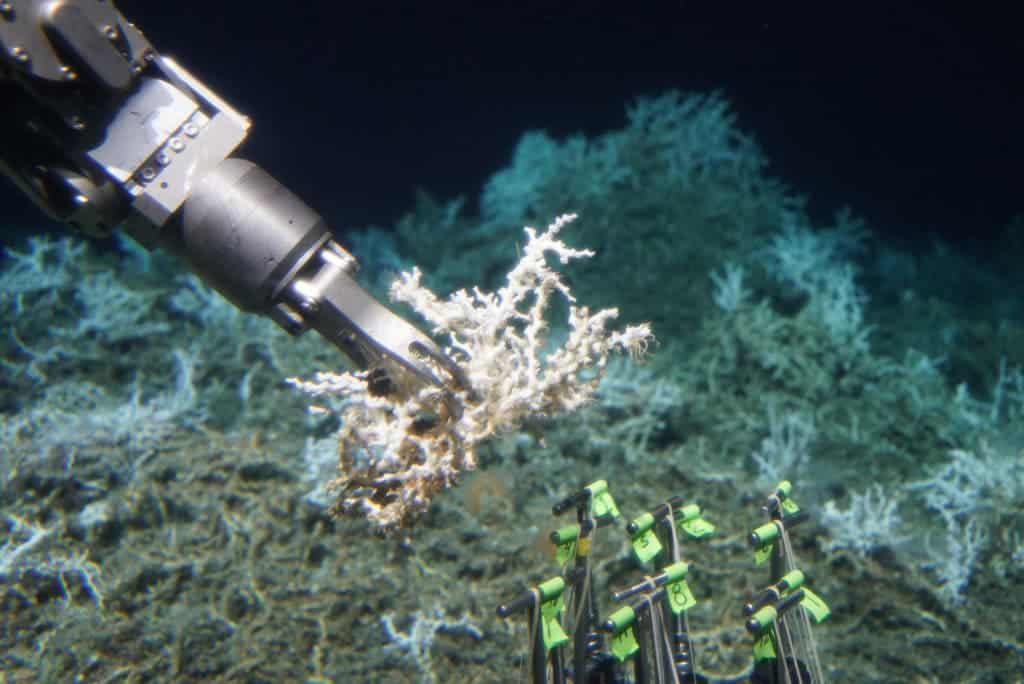A massive coral reef has just been discovered off the coast of South Carolina.

Alvin collects a sample of Lophelia pertusa from an extensive mound of both dead and live coral. Image credits: Woods Hole Oceanographic Institution.
We’d like to think that we’ve got Earth squarely under our thumb by now, but a new discovery comes to show that the planet still scoffs at us from time to time. Researchers from the National Oceanic and Atmospheric Administration (NOAA), the Bureau of Ocean Energy Management (BOEM), and the US Geological Survey (USGS) report finding a 260-kilometer (160-mile) long coral reef off the coast of Charleston.
Reefer madness
Despite exploring the Atlantic Ocean for nearly six centuries now, we don’t have a very good idea of what its depths hold. However, the discovery of the reef — announced earlier this week — definitely helps improve that image. Furthermore, it helps to flesh out our understanding of how and where corals can develop.
“This finding changes where we thought corals could exist off the East Coast,” Erik Cordes, the expedition’s chief scientist, told The Washington Post.
“And the function of the reefs, in terms of recycling nutrients, is critical to fuel surface productivity and the fisheries we rely on. This discovery is already changing our predictive models for corals, This will undoubtedly lead to new discoveries in the region once we can digest all of the information. That will take months to years.”
The discovery was made under the Deep Sea Exploration to Advance Research on Coral/Canyon/Cold seep Habitats (DEEP SEARCH) initiative, a five-year project that aims to explore the seas off the coasts of Virginia, North Carolina, and South Carolina. DEEP SEARCH aims “to improve knowledge of geology along the U.S. continental margin, the types of communities found on the seafloor, and the mid-water communities that interact with those seafloor communities”.
Judging by what the project’s website details of these areas — “massive submarine canyons and cold-seep communities” of algae that munch on natural gas rather than sunlight — they’re definitely a sight to behold. About a month ago, researchers aboard the research vessel Okeanos mapped several mound-like features on the seafloor.
Visiting the ocean’s bottom aboard the research submersible Alvin, researchers found evidence of coral, which had them understandably excited: as far as we knew, corals had no business living here. Alvin allowed them to take samples up to the surface for inspection. Analysis of these samples revealed that what was initially considered coral debris actually harbored living coral on the top layers.
“We thought that the structure would mostly be rock, and hopefully with live coral cover on top,” Cordes told The Washington Post.
“We have yet to find a single rock on any of these features. Just coral for miles and miles.”
The structures were bio-constructed entirely by corals over several thousand — or even hundreds of thousands — of years, the team explains. A video posted by the Woods Hole Oceanographic Institution shows a time-lapse of the dive: you can see the team pick up samples of corals a short distance to the south of where Okeanos identified the new reef. Most of those coral samples comprise of the species Lophelia — the same species whose rubble formes the reefs.
“As Lophelia grows and dies over time, new Lophelia grows atop the old skeletons, forming continuous reef structures that could stretch much farther than we ever imagined on the U.S. east coast,” explains Caitlin Adams, Web Coordinator at the NOAA Office of Ocean Exploration and Research.
Beyond their academic significance, the findings could also carry political weight. The US is looking to roll back bans on ocean drilling — a move that would reinstate offshore drilling leases, and has been publicly opposed by more than 140 municipalities, The Washington Post reports.
Back in January, the current administration has unveiled plans that would allow companies to drill in the US continental shelf, including in protected areas of the Arctic and Atlantic oceans. The BOEM has identified 47 areas where companies could essentially buy drilling permits.
“The goal of this whole project is to discover new, fragile habitats and make them priorities for BOEM’s management plan for the area in case it is opened up to drilling,” Cordes said.
“It is critical that we know where these places are, or they could be drilling right on top of a coral reef that no one knew was there.”
Enjoyed this article? Join 40,000+ subscribers to the ZME Science newsletter. Subscribe now!
Bagikan Berita Ini














0 Response to "A coral reef longer than Delaware was hiding off the US east coast"
Post a Comment